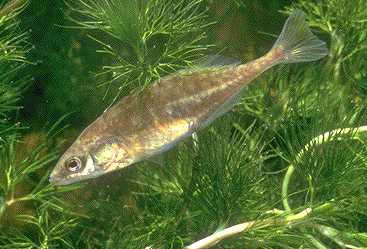| Gasterosteidae (Sticklebacks and tubesnouts) |
| 8.7 cm TL (male/unsexed); max. reported age: 2 years |
|
demersal; freshwater; pH range: 7; dH range: 15; depth range 0 - 55 m |
| North America: Nova Scotia to Northwest Territories and eastern British Columbia in Canada; Great Lakes-Mississippi River basins south to southern Ohio and Nebraska in USA and west to Montana, USA. Isolated population in Canadian River system in northeastern New Mexico, USA. Introduced elsewhere (Ref. 5723). Introduced in upper Inn drainage in Bavaria, Germany and accidentally in the 1960’s with Micropterus to southern Finland where it has established a population in Lake Lohjanjarvi (Ref. 59043). |
|
Diagnosed from other species of Gasterosteidae in Europe by combination of the following characters: 4-6 short dorsal spines, never inclined to the left or to the right; without keel on side of caudal peduncle; anal fin origin slightly behind dorsal fin origin; body dark olive green (getting blackish in breeding males), with numerous pale spots or undulating bars on flank (Ref. 59043). |
| Adults inhabit cool, vegetated, sand or mud bottoms of lakes and ponds. Also in pools and backwaters of creeks and small rivers (Ref. 1998, 10294). Rarely found in brackish water. Feed on crustacean and insect larvae, eggs and larvae of fishes, snails, oligochaetes and algae (Ref. 1998, 10294). Preyed upon by kingfishers, herons, and mergansers and occasionally by fishes like Salvelinus fontinalis and Esox lucius (Ref. 1998). Males build, guard and aerate the nest where the eggs are deposited (Ref. 205). |
|
Least Concern (LC); Date assessed: 15 November 2011 Ref. (130435)
|
| harmless |
Source and more info: www.fishbase.org. For personal, classroom, and other internal use only. Not for publication.
